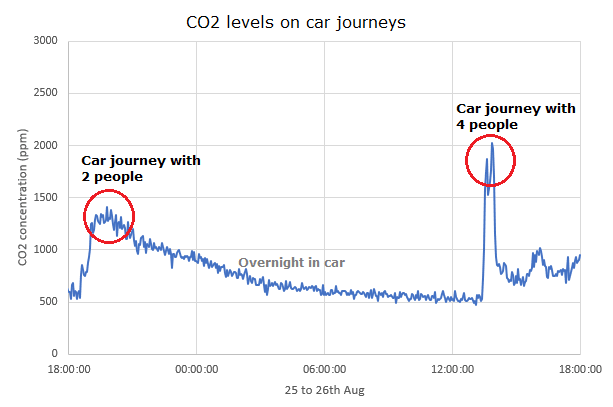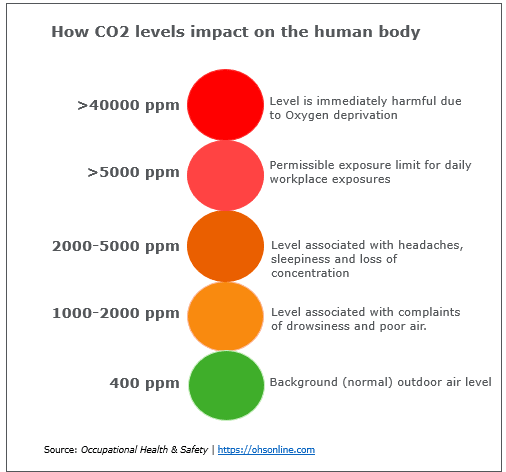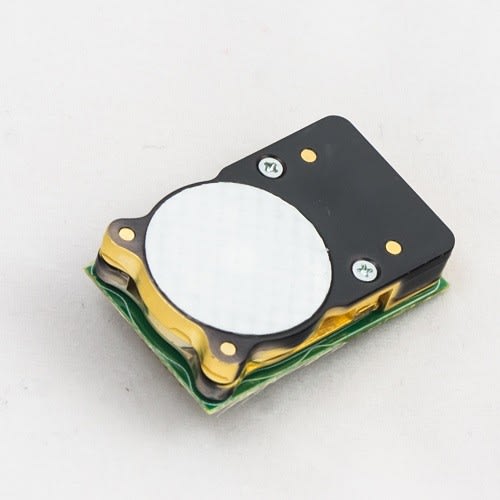Monitoring CO2 levels | CO2 Monitoring in Homes & Schools | DesignSpark
Follow articleHow do you feel about this article? Help us to provide better content for you.
Thank you! Your feedback has been received.
There was a problem submitting your feedback, please try again later.
What do you think of this article?
To most people, Carbon Dioxide (CO2) is simply a harmless gas that you cannot see or smell. It’s what we breathe out, what makes our drinks fizzy, and what we can use to extinguish fires.
Outside (or ambient) air typically contains around 400ppm (parts per million) of CO2[i]. On average, humans breathe out between 35,000-50,000 ppm of CO2 into the surrounding environment[ii]. While exhaled CO2 is naturally diluted in ambient air, this is not the case inside a building or enclosed space, such as in a restaurant, theatre hall, or in the office.
Where indoor CO2 concentrations are elevated, it’s usually due to the building’s occupants[iii]. This explains the stuffy and stale conditions often experienced. Therefore, the level of CO2 present can be an effective indicator of indoor air quality (IAQ).
This article observes 4 reasons why measuring CO2 in buildings is an important consideration.
1. Performance
Workers and students spend about half their time in classrooms and offices.[iv] This can mean large numbers of people spending several hours together in an enclosed room, with rising CO2 levels. According to the Technical University of Denmark[v], recent studies suggest that exposure to carbon dioxide at concentrations between 2,500 ppm to 4,000 ppm can have negative effects on human performance. And a study by the Harvard Chan School of Public Health found that increased CO2 levels caused a direct and negative impact on cognitive and decision-making skills. The study found that on an average peoples' cognitive scores dropped 21% with a 400 ppm increase in CO2[vi]
2. Speed of change
In a poorly ventilated room, or in an enclosed or confined area, levels of CO2 can increase in a very short space of time. For example, a research experiment carried out with the GSS CozIR®-A CO2 sensor found that in a car with 4 people inside, the level of CO2 reached 2000 ppm in only 20 minutes. This is the level where CO2 symptoms can start to cause loss of concentration, headaches and sleepiness for example.
3. Safety
In the most extreme cases, exceptionally high levels of Carbon Dioxide can be unsafe. Concentrations of greater than 40,000 ppm are immediately harmful due to lack of Oxygen and are potentially life threatening[vii]. For example, a leak in an enclosed area where CO2 is stored, such as in a beer cellar, can quickly fill the space with potentially dangerous levels of CO2.
4. Energy efficiency
Monitoring and controlling CO2 levels can help improve energy efficiency in buildings – saving money and helping to save the planet at the same time! According to a report by the Minnesota Department of Commerce[viii], implementing a Demand Control Ventilation (DCV) system can reduce energy consumption by over 30%. The reason is, a DCV system typically uses CO2 sensors to estimate the number of people in a building space. It only ventilates the air when required, rather than automatically switching on when it may not be necessary. This could be particularly effective in spaces with varying occupancy, for example in meeting rooms, theatres and school classrooms. Therefore, there’s huge potential for energy and cost savings for building owners, facility managers and tenants.
These are just 4 good reasons to monitor CO2 levels inside buildings and homes.
In terms of legislation, the Building Bulletin (BB) 101 states that ventilation should be provided in all learning spaces to control CO2 levels, and that concentrations should not exceed 1500 ppm[ix]. Therefore, maintaining suitable indoor air quality (IAQ) in schools and the workplace is important for alertness and productivity.
Indoor air quality can be measured and controlled with monitors and instrumentation. The quality of the air can then be controlled and adjusted as part of a ventilation system. This works by diluting high levels of CO2 and circulating fresh air back into the building. A suitable CO2 sensor is integrated into such a monitor or alarm system in order to provide real-time readings.
GSS’ award-winning CO2 sensors are so low power they can be integrated into battery-powered monitors. This could take the form of a handheld, portable or even wearable device depending on the application.
Typical NDIR CO2 sensors generally demand a lot of power, and so need be connected to a mains power supply. Because GSS sensors use LEDs as the source of infrared, they operate on very little power. This also makes the sensors very long lasting - over 15 years in some applications – which is ideal for ‘fit and forget’ applications.
[ii] http://www.energy.wsu.edu/Documents/CO2inbuildings.pdf
[iii] http://www.energy.wsu.edu/Documents/CO2inbuildings.pdf
[iv] http://www.energy.wsu.edu/Documents/CO2inbuildings.pdf
[v] http://orbit.dtu.dk/files/125818556/1_s2.0_S187770581502768X_main.pdf
[vi] https://www.airveda.com/blog/Why-We-Should-Measure-Carbon-Dioxide-CO2
[vii] https://ohsonline.com/Home.aspx
[viii] http://mn.gov/commerce-stat/pdfs/card-report-energy-savings-demand-control-ventilation.pdf
[ix] https://www.gov.uk/government/publications/building-bulletin-101-ventilation-for-school-buildings







